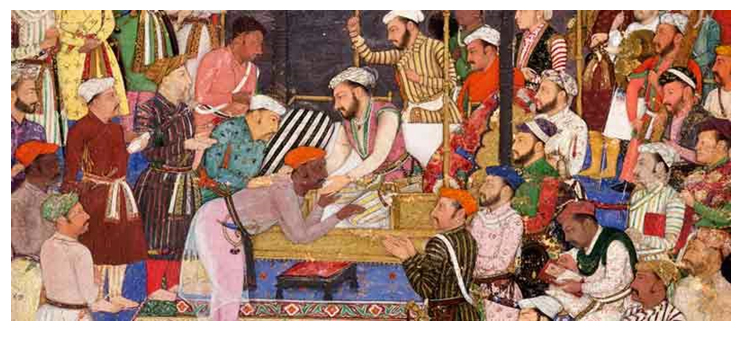
2.4 THE DELHI SULTANATE
1.The Sultanate of Delhi had five ruling dynasties with 34 kings.
2.The Slave dynasty (1206-90), Khilji dynasty (1290-1320), Tughlaq dynasty (1320-1413), Sayyid dynasty (1414-51), and Lodhi dynasty (1451-1526)
1.THE ILBARI OR SLAVE DYNASTY (1206-1290)
After Muhammad Ghori’s death, all the Muslim rulers who ruled over India from AD 1206-1290 were either slaves or were descendants of the slave rulers. So, the Dynasty is generally known as the Slave Dynasty.
The dynasty is also called Ilbari Dynasty, as all the rulers of this dynasty except Aibak belonged to the Ill Bari tribe of Turks.
1.QUTUBUDDIN AIBAK (1206-1210)
Originally a slave, Qutubuddin, because of his merit and loyal service was elevated to the post of Viceroy by Muhammad Ghori. After Ghori’s death, Aibak ruled over Delhi and founded his dynasty.
Lahore and later, Delhi was his capital.
For his generosity, he was given the title of lakh Baksh.
He also began the construction of Qutub Minar in the honour of famous Sufi Saint Khwaja Qutub-ud-Din Bakhtiyar Kaki.
Aibak was a great patron of learning, and patronised writers like Hasan-ul-Nizami, author of Taj-ul-Maasir and Fakhruddin, author of Tarikh-i-Mubarak-Shahi.
He fell from the horse while playing chaugan (Polo) and died.
ARAM SHAH (AD 1210)
After Qutubuddin’s death, his son Aram Shah succeeded him. Aram Shah proved quite incompetent. Some of the nobles rose to the occasion and invited Aibak’s son-in-law and Governor of Badaun, Iltumish to ascend the throne. He deposed Aram Shah and secured the throne for himself.
ILTUTMISH (AD 1211-1236)
He is considered to be the greatest slave king and the real consolidator of the Turkish conquest in India.
He made Delhi the capital in place of Lahore and was the son-in-law of Aibak.
Iltumish, during the early years of his reign, first consolidated his position by suppressing the revolts of the ambitious nobles.
In AD 1215, he defeated Yaldoz, who established himself as the independent ruler of Ghazi. He sent expeditions against the Rajputs in Ranthambore, Jalor, Gwalior, Ajmer and Malwa.
During his period, the Mongols under their leader Changez Khan made their appearance for the first time in India. He saved Delhi Sultanate from the wrath of Changez Khan by refusing shelter to Khwarizm Shah Jalaluddin Mangobarni, to whom Changez Khan was chasing.
He got his authority (Sultanate of Delhi) recognized by the Caliph of Baghdad (khalifa), as a member of the world fraternity of Islamic states.
He completed the construction of Qutub-Minar.
He constituted a group of 40 loyal slave Amins, known as Turkan-i-Chahalgani or Chalisa.
He started the Iqta system in Delhi Sultanate. This is an assignment of land in lieu of salary, which he distributed to his officers. Every Iqtadar had to maintain law and order, and collect revenue. After deducting his salary and the expenses of the government, he sent the surplus amount to the Central Government.
He introduced the Silver Tanka and Copper Jital.
He patronised Minhaj-us-Siraj, author of Tabaqat-i-Nasiri
He is called the father of Tomb Building (built by Sultan Garhi in Delhi).
RUKUNUDDIN FIROZ (AD 1236)
Iltumish appointed his daughter Raziya as his successor.
But most of the nobles could not reconcile themselves to the idea of a woman ruling over them and so they placed one of his sons Rukunuddin Firoz on the throne. He was a worthless person who left the work of the government in the hands of his mother, Shah Turkan.
Finally the throne was given to Raziya when he was out of the capital to curb a rebellion in Awadh against him.
RAZIYA SULTAN (AD 1236-1240)
She was the first and the last Muslim woman ruler of Medieval India.
Raziya successfully crushed the rebellion that occurred in Multan Lahore and Jhansi. The wazir Nizam-ul-Mulk Junaidi, who had opposed her elevation to the throne, was defeated by Raziya.
She also sent an expedition against Ranthambore to control the Rajput.
She discarded the female apparel and started holding the court with her face unveiled.
Her attempt to create a party of nobles loyal to her and the appointment of non-Turk Yakut to the high office led to opposition.
She herself led an expedition against the rebellious Governor of Lahore and forced him to acknowledge her suzerainty.
There was again a serious rebellion in Bhatinda. Altunia, Governor of Bhatinda refused to accept the suzerainty of Razia. Razia, accompanied by Yakut, marched against Altunia.
However, Altunia murdered Yakut and imprisoned Razia. Subsequently, Razia married Altunia and both of them marched towards Delhi, in AD 1240, Razia, became the victim of the conspiracy and was assassinated near Kaithal (Haryana) by the jats.
After Raziya, the battle of succession continued in which some rulers ruled insignificantly.
GHIYASUDDIN BALBAN (1265-1286)
Bablan ascended the throne in 1265, after killing all members of Iltumish’s family. He himself was a member of the Chalisa or Chahlgani and restored the prestige of the crown.
He created a strong centralised army and established the military department Diwan-i-Arz. He ordered the separation of military affairs from the finance department (diwan-i-wazarat). He also appointed spies.
He declared the Sultan as the ‘representative of God on the Earth’.
The Persian court model influenced Balban’s conception of kingship. He took up the title Zil-i-Illahi (shadow of god) and impressed pon the people that king was the deputy of God (Niyabat-i-Khudai)
He refused to laugh and joke in the court, and even gave up drinking wine. To emphasise that the nobles were not his equals.
He introduced Persian etiquettes like Sijda and Paibos (prostration before and kissing the monarch’s feet)
Balban started the festival of Nauroz. He adopted the policy of Blood and Iron.
He was a patron of Persian literature, and showed a special favour to Amir khusro.
Kaiqubad (AD 1287-90)
Grandson of Balban, he was put on the throne by Fakruddin, the kotwal of Delhi. But, Kaiqubad was killed by the Khilji rulers. This led to the end of the Ilbari dynasty and establishment of the Khalji dynasty.
